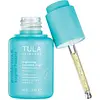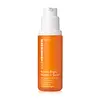What's inside
What's inside
 Key Ingredients
Key Ingredients

 Benefits
Benefits

 Concerns
Concerns

 Ingredients Side-by-side
Ingredients Side-by-side

Water
Skin Conditioning3-O-Ethyl Ascorbic Acid
Skin ConditioningLactococcus Ferment Lysate
Skin ConditioningPropanediol
Solvent1,2-Hexanediol
Skin ConditioningAscorbyl Glucoside
AntioxidantSodium Citrate
BufferingPentylene Glycol
Skin ConditioningCichorium Intybus Root Extract
MaskingMelia Azadirachta Leaf Extract
Skin ConditioningMelia Azadirachta Flower Extract
Skin ConditioningCorallina Officinalis Extract
Skin ConditioningCurcuma Longa Root Extract
MaskingOcimum Basilicum Flower/Leaf Extract
TonicLactic Acid
BufferingOcimum Sanctum Leaf Extract
Skin ConditioningVaccinium Vitis-Idaea Fruit Extract
AntioxidantCitrus Unshiu Peel Extract
MaskingHippophae Rhamnoides Fruit Extract
Skin ConditioningLitchi Chinensis Seed Extract
Skin ConditioningMangifera Indica Leaf Extract
Skin ConditioningGold
Cosmetic ColorantGlutathione
Hydroxyacetophenone
AntioxidantAcetyl Cysteine
AntioxidantSodium Sulfite
PreservativeSorbitol
HumectantCitric Acid
BufferingSclerotium Gum
Emulsion StabilisingXanthan Gum
EmulsifyingCaprylyl Glycol
EmollientAscorbic Acid
AntioxidantSodium Phytate
Lecithin
EmollientPullulan
Silica
AbrasiveSodium Chloride
MaskingSodium Benzoate
MaskingWater, 3-O-Ethyl Ascorbic Acid, Lactococcus Ferment Lysate, Propanediol, 1,2-Hexanediol, Ascorbyl Glucoside, Sodium Citrate, Pentylene Glycol, Cichorium Intybus Root Extract, Melia Azadirachta Leaf Extract, Melia Azadirachta Flower Extract, Corallina Officinalis Extract, Curcuma Longa Root Extract, Ocimum Basilicum Flower/Leaf Extract, Lactic Acid, Ocimum Sanctum Leaf Extract, Vaccinium Vitis-Idaea Fruit Extract, Citrus Unshiu Peel Extract, Hippophae Rhamnoides Fruit Extract, Litchi Chinensis Seed Extract, Mangifera Indica Leaf Extract, Gold, Glutathione, Hydroxyacetophenone, Acetyl Cysteine, Sodium Sulfite, Sorbitol, Citric Acid, Sclerotium Gum, Xanthan Gum, Caprylyl Glycol, Ascorbic Acid, Sodium Phytate, Lecithin, Pullulan, Silica, Sodium Chloride, Sodium Benzoate
Water
Skin ConditioningSqualane
EmollientDimethicone
EmollientCetearyl Alcohol
EmollientGlycerin
HumectantCaprylic/Capric Triglyceride
MaskingIsododecane
EmollientPolymethylsilsesquioxane
Mica
Cosmetic ColorantCoconut Alkanes
EmollientCI 77891
Cosmetic ColorantSclerocarya Birrea Seed Oil
HumectantDilinoleic Acid/Propanediol Copolymer
Emollient3-O-Ethyl Ascorbic Acid
Skin ConditioningCetearyl Methicone
Skin ConditioningSilica
AbrasivePhenoxyethanol
PreservativeCetearyl Glucoside
EmulsifyingXylitylglucoside
HumectantDimethicone/Vinyltrimethylsiloxysilicate Crosspolymer
Anhydroxylitol
HumectantMicrocrystalline Cellulose
AbsorbentPotassium Cetyl Phosphate
EmulsifyingStevioside
MaskingPolysilicone-11
Coco-Caprylate/Caprate
EmollientHydroxyethyl Acrylate/Sodium Acryloyldimethyl Taurate Copolymer
Emulsion StabilisingAcrylates/C10-30 Alkyl Acrylate Crosspolymer
Emulsion StabilisingXylitol
HumectantTocopherol
AntioxidantParfum
MaskingPotassium Azeloyl Diglycinate
Skin ConditioningCI 77491
Cosmetic ColorantDipotassium Glycyrrhizate
HumectantEthylhexylglycerin
Skin ConditioningGlucose
HumectantXanthan Gum
EmulsifyingSodium Citrate
BufferingCitrus Aurantium Dulcis Fruit Extract
MaskingCitrus Limon Fruit Extract
MaskingHippophae Rhamnoides Extract
MaskingLycium Barbarum Fruit Extract
AstringentRosa Canina Fruit Extract
AstringentSodium Hydroxide
BufferingLeuconostoc/Radish Root Ferment Filtrate
AntimicrobialPolysorbate 60
EmulsifyingSorbitan Isostearate
EmulsifyingAscorbic Acid
AntioxidantAroma
Sodium Chloride
MaskingCitral
PerfumingLimonene
PerfumingLinalool
PerfumingWater, Squalane, Dimethicone, Cetearyl Alcohol, Glycerin, Caprylic/Capric Triglyceride, Isododecane, Polymethylsilsesquioxane, Mica, Coconut Alkanes, CI 77891, Sclerocarya Birrea Seed Oil, Dilinoleic Acid/Propanediol Copolymer, 3-O-Ethyl Ascorbic Acid, Cetearyl Methicone, Silica, Phenoxyethanol, Cetearyl Glucoside, Xylitylglucoside, Dimethicone/Vinyltrimethylsiloxysilicate Crosspolymer, Anhydroxylitol, Microcrystalline Cellulose, Potassium Cetyl Phosphate, Stevioside, Polysilicone-11, Coco-Caprylate/Caprate, Hydroxyethyl Acrylate/Sodium Acryloyldimethyl Taurate Copolymer, Acrylates/C10-30 Alkyl Acrylate Crosspolymer, Xylitol, Tocopherol, Parfum, Potassium Azeloyl Diglycinate, CI 77491, Dipotassium Glycyrrhizate, Ethylhexylglycerin, Glucose, Xanthan Gum, Sodium Citrate, Citrus Aurantium Dulcis Fruit Extract, Citrus Limon Fruit Extract, Hippophae Rhamnoides Extract, Lycium Barbarum Fruit Extract, Rosa Canina Fruit Extract, Sodium Hydroxide, Leuconostoc/Radish Root Ferment Filtrate, Polysorbate 60, Sorbitan Isostearate, Ascorbic Acid, Aroma, Sodium Chloride, Citral, Limonene, Linalool
 Reviews
Reviews

Ingredients Explained
These ingredients are found in both products.
Ingredients higher up in an ingredient list are typically present in a larger amount.
You might know this ingredient as Ethyl Ascorbic Acid, a more stable version of ascorbic acid.
Like other types of vitamin C, this ingredient has many benefits including reducing wrinkles, skin soothing, dark spot fading, and fighting against free radicals.
3-O-Ethyl Ascorbic Acid interferes with the process of skin darkening, helping to reduce hyperpigmentation. It also encourages the skin to produce more collagen.
Once applied, 3-O-Ethyl Ascorbic Acid is converted to Vitamin C deeper in the skin's layers. This process is slow but makes this ingredient more tolerable for skin.
The optimum pH range for this ingredient is 4 - 5.5
Learn more about 3-O-Ethyl Ascorbic AcidAscorbic Acid is is pure Vitamin C. This form makes up the largest amount of vitamin C found naturally in our skin.
Not only is vitamin C great for your overall health and immune system, it also has plenty of benefits on your skin.
Vitamin C is best used for brightening skin. It improves dark spots, acne scars, and hyperpigmentation. This is because it blocks the process of skin darkening when exposed to UV.
Remember: Vitamin C should not replace sunscreen!
Your skin uses vitamin C to build collagen. Collagen is one key component in having a strong skin barrier and plump skin. Vitamin C also plays a role in regulating collagen, thus making it effective in improving wrinkles and fine lines.
Ascorbic acid shows potent antioxidant activity. As an antioxidant, it helps fight free-radicals. Free-radicals are molecules that may damage your skin cells. These antioxidants also protect skin against UV damage.
The best formulations include Vitamin E and/or ferulic acid. These two ingredients help stabilize and provide a boost in the benefits of ascorbic acid. This is because ascorbic acid becomes unstable when exposed to UV and air. In fact, you can tell your ascorbic acid has oxidized when it turns an orange-yellow color.
Ascorbic acid is generally compatible with other ingredients. However, using ascorbic acid with other active ingredients might cause irritation. Two ingredients: copper ions and benzoyl peroxide, will inactivate ascorbic acid completely.
Read more about other types of Vitamin C:
Foods rich with vitamin C include oranges, strawberries, broccoli, bell peppers, and more. When consuming Vitamin C, your skin receives a portion of the nutrients.
Learn more about Ascorbic AcidSilica, also known as silicon dioxide, is a naturally occurring mineral. It is used as a fine, spherical, and porous powder in cosmetics.
Though it has exfoliant properties, the function of silica varies depending on the product.
The unique structure of silica enhances the spreadability and adds smoothness, making it a great texture enhancer.
It is also used as an active carrier, emulsifier, and mattifier due to its ability to absorb excess oil.
In some products, tiny microneedles called spicules are made from silica or hydrolyzed sponge. When you rub them in, they lightly polish away dead skin layers and enhance the penetration of active ingredients.
Learn more about SilicaChances are, you eat sodium chloride every day. Sodium Chloride is also known as table salt.
This ingredient has many purposes in skincare: thickener, emulsifier, and exfoliator.
You'll most likely find this ingredient in cleansers where it is used to create a gel-like texture. As an emulsifier, it also prevents ingredients from separating.
There is much debate on whether this ingredient is comedogenic. The short answer - comedogenic ratings don't tell the whole story. Learn more about comegodenic ratings here.
The concensus about this ingredient causing acne seems to be divided. Research is needed to understand if this ingredient does cause acne.
Scrubs may use salt as the primary exfoliating ingredient.
Learn more about Sodium ChlorideSodium Citrate is the sodium salts of citric acid. In skincare, it is used to alter pH levels and acts as a preservative.
Its main functions are to maintain the pH of a product and neutralize metal ions.
The acidity of our skin is maintained by our glands and skin biome; normal pH level of skin is slightly acidic (~4.75-5.5).
Being slightly acidic allows our skin to create an "acid mantle". This acid mantle is a thin barrier that protects our skin from bacteria and contaminants.
Learn more about Sodium CitrateWater. It's the most common cosmetic ingredient of all. You'll usually see it at the top of ingredient lists, meaning that it makes up the largest part of the product.
So why is it so popular? Water most often acts as a solvent - this means that it helps dissolve other ingredients into the formulation.
You'll also recognize water as that liquid we all need to stay alive. If you see this, drink a glass of water. Stay hydrated!
Learn more about WaterXanthan gum is used as a stabilizer and thickener within cosmetic products. It helps give products a sticky, thick feeling - preventing them from being too runny.
On the technical side of things, xanthan gum is a polysaccharide - a combination consisting of multiple sugar molecules bonded together.
Xanthan gum is a pretty common and great ingredient. It is a natural, non-toxic, non-irritating ingredient that is also commonly used in food products.
Learn more about Xanthan Gum